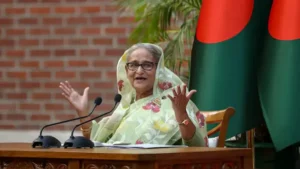Despite the country’s curfew, the death toll in Bangladesh rises as fighting over the distribution of government positions rages on. Additionally, the army has been sent around the country to maintain law and order. A few Indian students have begun to return home in the meantime.
The demonstrations started several weeks ago, but at the beginning of this week, student demonstrators were attacked by activists from the Bangladesh Chhatra League, the student branch of the Awami League party, which is led by Prime Minister Sheikh Hasina.
Deadly violence broke out as soon as tensions spiked. In the capital of Dhaka, thousands of students engaged in combat with armed police. It looked like several official Bangladeshi websites had been compromised. “Stop Killing Students” was one of the messages posted on the Prime Minister’s Office website. Then, in bold, blood-red letters, “It’s no longer a protest.” Now it’s a war.
What is the purpose of the student protests in Bangladesh?
Numerous thousands of students have protested in the streets, calling for the removal of a quota system that allocates up to 30% of government positions to the kin of veterans who participated in Bangladesh’s 1971 war of independence against Pakistan. Tensions increased on Monday after student activists at Dhaka University, the biggest university in the nation, battled with police, and a counter-protest exacerbated the situation. The protests started late last month.

Up until earlier this week, when the student branch of the ruling Awami League party attacked the demonstrators, the students said the protests were nonviolent. Since then, hundreds of people—including police officers—have been hurt. In response to violent clashes in the country’s capital, Dhaka, and other major cities, police and security personnel in Bangladesh on Friday opened fire on protestors with tear gas and bullets. The authorities also turned off telephone and internet connections.
The latest conflicts come after the bloodiest protest day so far, Thursday, July 18, when demonstrators tried to impose a “complete shutdown” across the nation, killing 22 people, most of them college students.
What is the order from the Supreme Court?
The Supreme Court ruled on Sunday that veterans of the conflict will receive 5% of government posts. With the remaining 93% being awarded based on merit. The remaining two percent will go to transgender and disabled individuals as well as members of ethnic minorities.
After officials from both sides convened late on Friday to deliberate a resolution, the students were awarded a partial victory with the decision. Anisul Huq, the minister of law, has stated that the administration was willing to talk about their requests.
Here are the key updates till now

- Days after clashes over government job allocation, violence in Bangladesh persists. According to several reports, the death toll has increased to 115.
- Over the past few days, demonstrators and police have battled in Dhaka and other cities’ streets and on university campuses.
- Authorities sought to obstruct online communications by outlawing internet and cellphone services, according to AFP. Additionally, a few television news channels stopped airing, while the majority of Bangladeshi publications’ websites stopped loading or updating.
- Bangladesh is under a harsh curfew, enforced by the police. To maintain peace and order, military personnel are policing the nation’s capital and other areas.
- The Awami League general secretary, legislator Obaidul Quader, was quoted by the AP as saying that there was also a “shoot-at-sight” order in existence. It allowed security forces to open fire on crowds in extreme circumstances.
- Through a variety of land ports, 778 Indian students have returned home. According to the Ministry of External Affairs (MEA), some 200 students have also used normal aircraft services to return home through the airports in Dhaka and Chittagong.












Be First to Comment